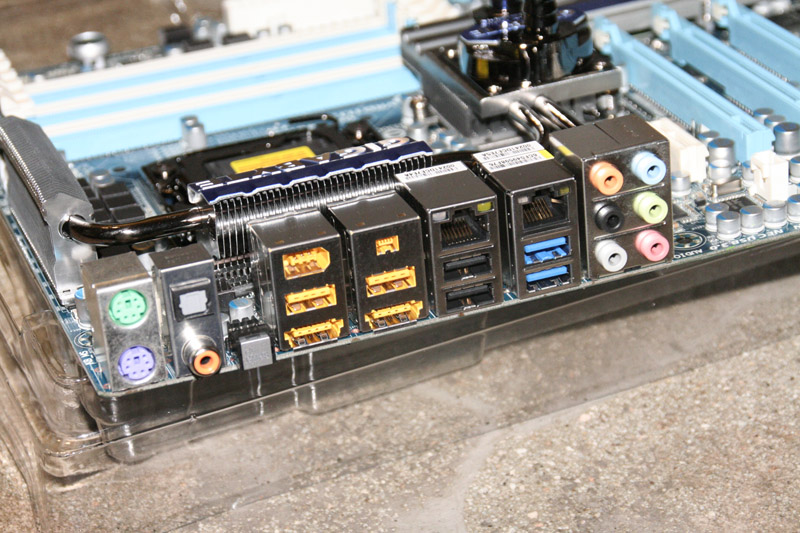Gigabyte Adds SATA 6 Gb/s, USB 3 For AMD
Gigabyte brings USB 3.0 and SATA 6.0 Gb/s goodness to AMD users.
USB 3.0 is one the most talked about technologies as of late, despite the fact that accessories and drives have yet to really emerge. Gigabyte is beginning to include USB 3.0 on some of its latest P55 and X58 boards as well as its AMD boards. Gigabyte told us that it will implement USB 3.0 and SATA 6.0 Gb/s across its entire lineup going forward. The following are charts from Gigabyte that indicate which boards the company is currently shipping with support for USB 3.0 and SATA 6.0 Gb/s:

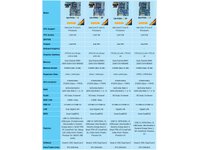
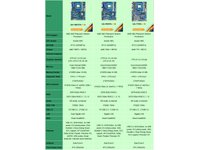
Out of Gigabyte's current crop of eight boards, the beefiest Intel board is Gigabyte's GA-EX58A-UD7, while the GA-790FXTA-UD5 takes the front for AMD. The "A" at the end of the chipset moniker denotes a board with USB 3.0 and SATA 6.0 Gb/s. Gigabyte's fast adoption of USB 3.0 and SATA 6.0 Gb/s hopefully means we won't have to wait too long before device manufacturers come out with supporting devices.
We briefly tested with an external Buffalo USB 3.0 1 TB drive. Knowing that the 1 TB Samsung Spinpoint HD103SJ HDD wouldn't do justice, we removed it and swapped in an Intel X25-M G2 80 GB drive and that gave us a fast 238 MB/s rate. Clearly, USB 3.0 has a lot of headroom and is plenty fast enough to handle any current generation SATA 3.0 Gb/s device.
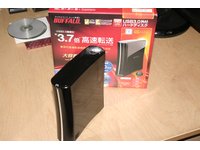
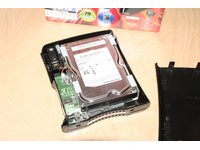
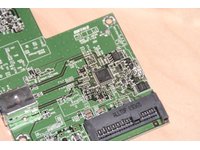
Unfortunately, the back-end of the Buffalo drive is also a SATA 3.0 Gb/s. so it won't support any upcoming SATA 6.0 Gb/s drives. Despite this, even today's fastest SSDs aren't fast enough to saturate SATA 3.0 Gb/s.
The highlight of the bunch is Gigabyte's GA-790FXTA-UD5, which sits at the top of Gigabyte's AMD offering.

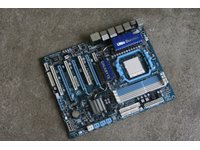
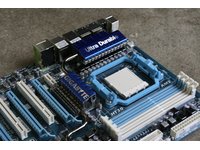
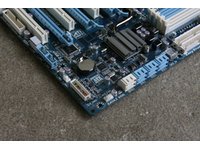
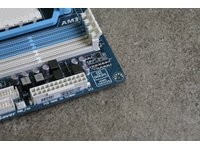

In our recent review of Gigabyte's P55A-UD4P, we indicated that Gigabyte's entire P55 lineup had PCIe lanes dedicated to supporting the onboard USB 3.0 and SATA 6.0 Gb/s controllers, effectively limiting bandwidth to the graphics cards. Here's a quote from that review:
Two of the primary graphics card’s 16 PCIe lanes supply its USB 3.0 and SATA 6.0 Gb/s controllers, and Gigabyte disables six more lanes to make the upper slot an effective x8 interface. The USB 3.0 and SATA 6.0 Gb/s controllers revert to the chipset’s 2.5 GT/s lanes whenever two graphics cards are installed, to preserve the x8 transfers each graphics card needs for optimal CrossFire or SLI performance.
Get Tom's Hardware's best news and in-depth reviews, straight to your inbox.
Thus, users with a single graphics card must sacrifice half of its peak bandwidth to enable 5.0 Gb transfers to the USB 3.0 and SATA 6.0 Gb/s controllers, while those with two cards must live with 2.5 Gb/s bandwidth limits on USB 3.0 and SATA 6.0 Gb/s controllers. Neither of these sacrifices is huge or even noticeable on most of today’s hardware, yet anyone trying to future-proof their system could be left cold.
Fortunately for AMD users, the GA-790FXTA-UD5 doesn't suffer from the same limitations because AMD's 790FX has a total of 48 PCIe lanes while the P55 chipset only has 16.
The GA-EX58A-UD7

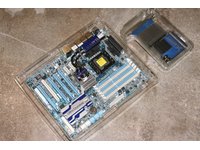
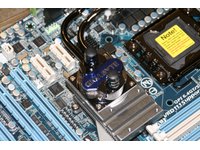
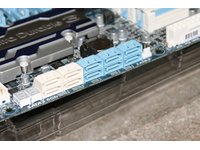
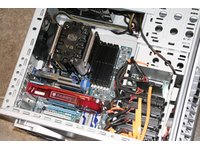
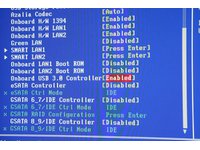
Gigabyte says that it's X58A-UD7 is its top of the line board, and rightly so. Not only is the board USB 3.0/SATA 6.0 Gb/s ready, it even comes with support for liquid cooling. If you don't have a liquid cooling setup, the board ships with a separate heatsink module that attaches to the chipset module. Simply fill in the gap with something like Arctic Silver and screw down the heat sink board. In fact, you can use both the supplied heatsink board and liquid cooling if you so choose.
On the rear of the GA-EX58A-UD7, Gigabyte has implemented a combo eSATA/USB solution, in that both of the eSATA connectors also support USB connections. The two blue USB connections at the end are USB 3.0 ports but will also take USB 1 and USB 2 devices.
Gigabyte indicated that its X58 based boards, like its 790FX boards, do not have the PCIe lane limitation of the P55 boards. Gigabyte will add to its P55 lineup with a GA-P55A-UD7, which will integrate PLX and nForce 200 PCIe bridges by the end of December. In our recent review, we found that the PCIe lane sharing with the high-speed USB 3.0 and SATA 6.0 Gb/s controllers doesn't really impact performance in today's apps but those who choose to use CrossFire or SLI on P55 will have to sacrifice USB 3.0 and SATA 6.0 Gb/s--at least until Gigabyte ships its GA-P55A-UD7.
-
duckmanx88 noob questions: will you see a performance hit when using a PCI-E 2.0 card in a regular x16 PCI-E slot and is there a performance hit/difference between using cards in sli/crossfire in (x16/x16) versus (x8/x8)? an example of the card would be 5850's or maybe 275's. a bit off topic but i'm confused about the whole "lanes" talk in the article.Reply -
Honis duckmanx88noob questions: will you see a performance hit when using a PCI-E 2.0 card in a regular x16 PCI-E slot and is there a performance hit/difference between using cards in sli/crossfire in (x16/x16) versus (x8/x8)? an example of the card would be 5850's or maybe 275's. a bit off topic but i'm confused about the whole "lanes" talk in the article.No. Read the whole article.Reply
Gigabyte indicated that its X58 based boards, like its 790FX boards, do not have the PCIe lane limiation of the P55 boards.
Obligatory spelling correction: limitation* -
maximus20895 I like thisReply
Gigabyte has implemented a combo eSATA/USB solution, in that both of the eSATA connectors also support USB connections. -
False_Dmitry_II Those combo plugs are also for non-standard devices that talk over the SATA interface but are powered from the USB connection.Reply -
falchard Never liked the layout of Gigabyte boards. Whats with the 3 PCI slots instead of variations of PCI-e?Reply -
elel Wow. They're going to have to introduce a larger IO panel on future cases. About the board - I want one!Reply -
tmc Adding usb 3.0 & sata 6 (really sata 3 @ 600MBts thruput) to motherboards are a GIMMICK to be able to charge $100 more for the motherboards. Nothing more. The limited hardware vendor support is a true indication of that early adopter premium. They motherboard makers could have at least partnered with other companies to provide for "affordable hardware", but no.. this is for the rich status class of having new technology first. Just as you may've been the first on your block with a BLUE RAY player, then recorder, etc. The day will come when it will cost the same as our current lineup of boards with 2.0 and sata II (300). The tech industry is swinging the pendulum back to OBSOLESCING technology just as we did in the 1980s again. You only have to look at the flash industry.. SD is setting the cutoff point for sdhc @ 32gb, then rushing head-long into sdxc (2tb cutoff-- maybe, first make the capacity-- then we'll see how long it lasts). There will probably be some backwards compatability to sdhc, but sd is all but dead. You don't even see cards sold anywhere anymore. My advice is to avoid the early adopter premium to line the pockets of these companies and let them recoup their investments over a LOOOONGER period of time-- that way they won't be so fast is obsolescing it so quick. Just look at AGP, it had a nice 4-6 year run until bandwidth madness caught fire, of course to compensate for the lack of adequate broadband infrastructure across the USA.Reply
